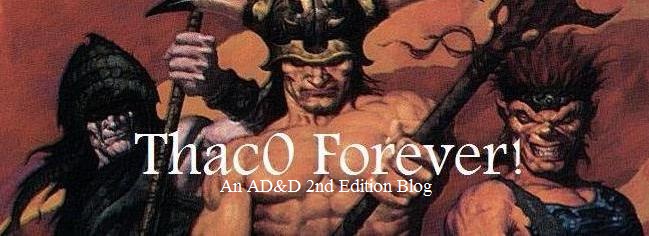This blog was inspired by a thread over at the dragonsfoot 2e forum on the massive amount of supplementary proficiencies that appeared during 2nd edition. This post is thus my 2 pence on the subject. In my campaigns, proficiencies do not tell what your character can and can't do. They tell what skills your character specializes in beyond, what your character is skilled at beyond the average man.
It was always my understanding, that when you strip 2nd edition down to its very core, the basic non-combat action resolution system for the game was a d20 roll vs. the character's appropriate ability score with modifiers as the DM sees fit to represent difficulty, with a roll of 1 always indicating a success and a roll of 20 always indicating a failure.
Some proficiencies, such as reading/writing and language, are, under most DMs considered to be can or can't do proficiencies. If the character has the proficiency he can read, write, speak, or understand the language or document in question. In my campaigns, this is not so.
Anyone who has ever tried to stat themselves out using D&D rules finds that they must spend a lot of additional proficiencies beyond what even the average Wizard with 18 intelligence would have. While I'm sure we'd all like to believe that we're all just that snazzy, I'd like to offer an alternative viewpoint.
The average person, modern, ancient, or medieval has certain inherent skills based on the way he was raised. The average lower class serf might not know how to read or write, but he would know when it's about the right time to plant crops, even if he doesn't have the agriculture proficiency. The average person in the middle ages might not know the fine art of smithing, but he's probably seen the local smith perform his craft enough times to understand the basics. His final product may not be as good, and almost certainly will be nowhere near as pretty, but there's a decent chance that his final product will be functional, especially if it's just simple repair work.
Reading/writing and languages are one of those tricky ones you just want to have the ability, don't have the ability. I think that there are some things a person should be able to read if the character has had significant exposure. If the character grew up in a society that values reading, even if he doesn't have the read/write chance, there's a good bet he'd still be able to recognize his name when he sees one. Also, don't forget that many professions have special symbols which are basically a type of writing in and of themselves, but don't actually count as reading/writing. I'll discuss this more in a later post.
In my campaigns, any proficiency a character doesn't have but attempts to use is handled as being a normal proficiency check, but with an additional penalty added to the normal modifiers. Normally this penalty will range from -1 to -5, though if the character is trying something truly complicated or difficult, such as using the cantrip proficiency without any magical training whatsoever, a -10 penalty would not be unreasonable, with a -15 perhaps in low magic settings.
Demons: The Game of Evil Spirts (1979)
3 hours ago


